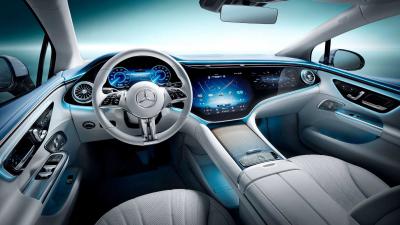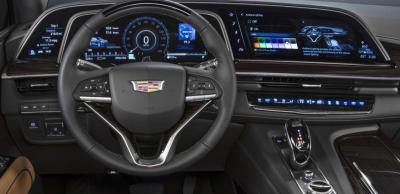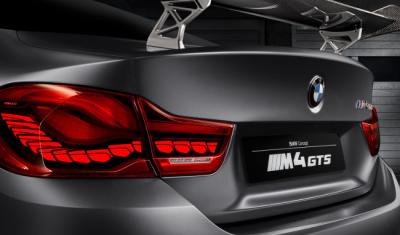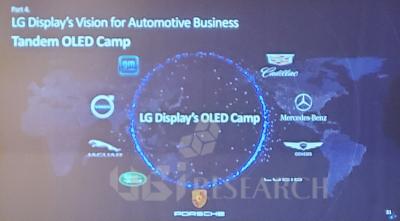OLED is a light-emitting technology used to create thin, efficient and flexible displays and lighting panels. OLEDs are useful in many applications, such as TVs, smartphones, wearables, laptops - and also automotive displays and lighting solutions.

Where can you OLEDs in cars?
There are several possible (and existing!) applications for OLED displays and lighting systems in cars:
- Dashboard displays (instrument clusters, navigation, media, HVAC...)
- Heads up displays
- Internal lighting
- External lighting (tail lights, turn indicators)
- Digital rear-view internal mirrors
- And more application we cannot think about today!
OLED displays for cars today
Several car models already use OLED displays today. Simple PMOLED displays have been adopted by automotive makers for many years, for example the Lexus 2010 RX for example has a white OLED display, supplementing the main 8" display.
Starting in 2021, automotive makers started to also adopt AMOLED displays in premium cars. The 2021 Mercedes S-Class for example comes standard with a 12.8-inch OLED, and the 2021 Cadillac Escalade sports a large 38-inch LGD P-OLED display (made from several displays). More recent examples include the 2024 Genesis GV70 and the Nio ET9.

We expect this trend to continue, as OLED makers such as LGD, SDC, BOE and others accelerate automotive AMOLED development.
OLED lighting in cars
The automotive market is one of the most interesting markets for OLED lighting, and one of the only markets in which OLED lighting finds early success. In 2016 Audi unveiled the 2016 TT RS, which sports optional OLED taillights - the first commercial car to sport the new lighting technology. Since then several models from Audi, BMW, Hongqi, Mercedes and others have adopted OLED lighting panels.

Zeekr introduces its 2024 009 MPV, with two OLED displays
China-based EV maker Zeekr introduced the 2024 Zeekr 009 model, a 4/6/7 seater MPV. The new model has two OLED displays: a 15.05" 2.5K flexible OLED main front screen, and a 17" 90Hz 3K ceiling-mounted passenger screen. The 15.05" OLED display seems to be the same display used in the 2024 Zeekr 001 model.
The 2024 Zeekr 009 will feature several seating options, NAPPA leather seats with headrest speakers, ventilation, heating and massage functions, exclusive lounge-chair mode, 30-speaker sound system and high performance - it reach go from 0 to 100 km/h in 3.9 seconds and has a driving range of up to 740Km. Zeekr plans to start delivering the all-new Zeekr 009 to customers in China next week, starting at 439,000 RMB (around $60,000).
LG Display developed new tandem OLED technology to increase brightness and efficiency by 20%
According to a new report by Business Korea, LG Display is finalizing the development of its 3rd-gen tandem-stack automotive OLED technology, and aims to start mass producing these panels by 2026. LGD believes the new panels will improve the brightness and efficiency of its OLEDs by 20% (compared to its current 2nd-gen tandem OLEDs).
LG Display believes it is leading the industry with its tandem OLED technology (and we tend to agree) and it hopes to accelerate its technology development to widen its lead. LG Display is enjoying a lead in the automotive display market with its OLED solutions and has already achieved design wins with many companies, including Genesis, Mercedes-Benz, Cadillac and GM.
Is LG Display leading over Samsung Display with the quality and performance of its latest OLED?
Since Samsung started mass producing AMOLED displays in 2007, most people believe that the company is not only the leader in OLED production capacity, but also in the performance of its displays. In most cases, Samsung has been the first company to develop and manage to mass produce the most advanced OLED displays, and the first to adopt the latest OLED materials, architectures, and processes.
There are some signs that this could be changing, although honestly it's a bit too early to know. In May 2024, Apple launched its first OLED Tablets, and according to reports, Apple chose LG Display as its main supplier, ordering around 60% of its iPad OLEDs from LGD (with all of the 13" model orders going to LG), and the rest from Samsung. Later it was reported that Apple had to delay the introduction of its 2024 iPad Pro devices as Samsung faced low production yields and could not deliver displays in time.
Tianma shows its latest OLEDs and MicroLEDs at Displayweek 2024
China-based Tianma had an impressive booth at Displayweek 2024, showing numerous OLED and microLED displays and prototypes.
For the automotive market, Tianma showed three new display prototypes. First up is a 13" slidable OLED, with an embedded touch panel, aimed towards car dashboards or center controls.
Visionox shows its latest OLED and MicroLEDs at Displayweek 2024
During Displayweek 2024, Visionox demonstrated many OLED display technologies and panels, and also an interesting microLED prototypes (produced by its subsidiarity Vistar).
Visionox is in the final stages of development of its ViP maskless display production process, and the company showcased some nice ViP smartphone panel prototypes (the technology can be used for any panel size). ViP offers a high improvement in aperture ratio (69% up from 29%) which results in low power consumption and brightness (up to 4X according to Visionox), improved lifetime (up to 6X), improved PPI and more.
BOE shows new OLED displays at SID Displayweek 2024
BOE had a large demonstration at Displayweek 2024, showing several display technologies and many new panels and prototypes.
First up we have a slidable OLED display, one of the largest we've seen, at 31.6". The display offers a resolution of 5944x1672, a sliding distance of just over 260 mm (BOE says its the world's longest) and a sliding radius of 5 mm.
LG Display shows its latest OLED displays at Displayweek 2024
LG Display demonstrated its latest OLED display prototypes and commercial panels at Displayweek 2024. The company showed flexible panels, automotive displays, transparent OLED, gaming monitors, a 10k nit microdisplay and more.
So first up, LG Display shows its automotive Advanced-Thin-OLED (ATO) displays, which are produced on glass substrates and use a tandem structure. These OLEDs are lower in cost compared to LGD's flexible automotive p-OLED panels, but still enable low-weight and thin profile, and the excellent image quality of an OLED display. The smaller display was a 12.3" 2400x900 (209 PPI) 1,000 nits panel, while the other panel was larger at 17" 1920x2560 (188 PPI).
Samsung shows its latest OLED and QD-EL displays at Displayweek 2024
Samsung Display had a rather large booth at Displayweek 2024, showing its latest OLED displays and technologies. Samsung showed several displays - including foldable smartphone panels, laptop and tablet displays, two QD-OLED displays, its 9.4" round automotive AMOLED, and more.
One interesting display was a panel that combines a foldable and a rollable display, that can open up to an impressively large display. Samsung brands it as a Flex Note Extendable Display.
Sharp withdraws from the LCD TV market, the future of its display business is unclear
Japan-based Sharp Corp, an LCD display industry pioneer, announced that it will stop all of its large-area LCD production by the end of 2024. Sharp's Osaka-based factory was the last LCD TV fab in Japan, and it will be turned into a data center run by its subsidiary Sakai Display Products Corp.
Sharp says that its current midterm plans are strengthen its home appliances and office equipment businesses, by incorporating AI technologies. It also plans to sell its semiconductor business. Sharp says it will focus its remaining small/medium LCD display business on the automotive and VR sectors.
OLEDWorks confirms it is supplying the OLED lighting panels for Audi's 2024 Q8 SUV
In 2023, Audi unveiled the 2024 Q8 and SQ8 SUVs, which sports optional OLED taillights, similar to the ones used in the 2022 Audi A8. We assumed that the OLED panels were supplied OLEDWorks, and the company indeed formally confirmed that the 2024 A8 uses its Atala OLED technology.
The Q8 uses Audi's first-gen design, as it was in the 2022 A8. A total of six panels—each less than one millimeter thick—span the rear of the car. One panel occupies each of the left and right bodyside lamps, and four panels span the continuous inner tailgate lamp. Every panel contains six high-contrast segments that are individually addressable via software control.
Pagination
- Page 1
- Next page








